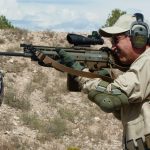by Robert Shimizu

Gunsite’s Battle Rifle is a study of the .30 caliber semi-automatic Main Battle Rifle, and its proper employment in armed conflict. Compared to the 5.56×45 round, the 7.62×51 NATO round packs a heavier punch, offers greater effective range, is less prone to drifting in the wind and tends to find its way through things, turning yesterday’s cover into today’s concealment.
For some years, I searched for a rifle in this caliber that exhibited the handiness and ergonomics of the AR platform. I have owned an HK-91, An AR-10, an SR-25, a match-tuned M1A and a SOCOM-16. I’ve also tried the FN/FAL, an effective if weighty affair. These are uniformly HEAVY, cumbersome pieces with ergonomics more suited to larger men than I.
I’ve found “today’s rifle”. It is the FNH-USA SCAR 17S. I have mine, and you should get yours.
The FNH-USA SCAR 17S is the latest evolution in the Main Battle Rifle. It’s a handy piece that weighs in at 8 lbs. unloaded. The stock is instantly adjustable for length of pull, folding entirely out of the way for vehicle-mounted operations. The movable cheek-piece can be raised for a range of optics. All controls are ambidextrous, with generous rails around the rifle for mounting accessories. This is the rifle that SOCOM troops have asked for, and are apparently testing today.
The SCAR 17S is ACCURATE. I have hit six-inch steel targets at 350 yards using this rifle with my Leupold 3 X 9 mildot scope. I have hit steel silhouettes at 640 yards and heavy Pepper Poppers out to 750 yards with the Trijicon ACOG 3 X 35 sight. I suspect that this is a one-MOA rifle out of the box, but for me “minute of bad guy” accuracy is all that I require. The SCAR easily exceeds my requirements.
There are trade-offs. I cannot easily reach the AR-style safety on the port side, but since the control is ambidextrous, I use the starboard safety with my index finger. Also, the bolt handle reciprocates with the bolt carrier, impacting everything in its way. That includes your support side thumb. The “fix” is to keep your thumb down or move the bolt handle to the starboard side of the weapon.
In our Battle Rifle class we had two perennial Gunsite students, Charles McCrary and Mike Crew, both former US Customs agents. We also had Walt Hasser of FNH-USA, Director of Marketing for the US-based SCAR product line (a Recon Marine). Walt’s companion, Fred Branhan, is Browning/FNH’s SCAR Armorer. He assembles and tests each weapon before it leaves the factory. If you buy a SCAR, Fred will have touched it first. Also in attendance was Lt. Col. Guy Coursey, USMC. He is an outstanding marine and a Gunsite Adjunct Instructor.
Rangemaster Chris Weare’s laid-back California style conceals deep experience and total awareness. Chris served as a Recon Marine in Vietnam, later spending 30 years in the Orange County Sheriff’s Department as a Bomb Technician and small arms instructor. His eyes miss nothing.
Coach Walt Wilkinson is lofty both in stature and experience. He served thirty years in the US Army, 26 of them in the Special Forces, retiring with the rank of Sergeant Major. He is a surpassing shot with a rifle, and a thoroughly “been there/done that” sort of fellow. One wonders how many young troopers’ lives have been saved by Walt’s example and his teachings.
Thus we had superior instructors and a deeply experienced group of students. The only non-military or LE student in the class was me, a mainframe software executive. I faced a strong challenge.
The weapons: Three AR-10 platform guns in .308 (one shot by Coursey), two FN/FALs shot by McCrary and Crew, and three SCARs, shot by Hasser, Branham and myself. A fourth SCAR 17s hung from the single-point sling of Instructor Wilkinson.
Performance: EVERY AR-10 platform gun malfunctioned because of bad magazines, poor lubrication or gas problems. The FN/FALs had magazine problems. Meanwhile, the SCARs just WORKED, as reliable as hammers. I cannot recommend the SCAR platform too highly.
Each gun had some sort of optic. Mine was the Trijicon 3 X 35, with a T1A1 red-dot perched atop it. Hasser had a Leupold Mark 4 MR/T (2.5-8 X 36mm) with cross-hair reticle and a red-dot. Coursey had a Trijicon Accupoint. Each sight provided some sort of magnification with illuminated reticle or dot.
The Trijicon ACOG is an ingenious piece of kit, bullet drop-compensated for a 168grn bullet at 2925 fps. It’s a BATTLE sight, superb at delivering aimed fire quickly to “minute of bad guy” accuracy standards at intermediate ranges out to 300 yards. Beyond that, one has a graduated set of stadia that can be used at various ranges. It’s a fine, durable piece of kit. In Arizona sunlight, the aiming dot is overly bright so I “attenuated” it with black tape along the length of the fibre-optic.
Throughout the class we were head-quartered at the York Range. This is a 200-yard Known Distance range with two heavy steel targets and eight turning target arrays.
Our first morning was spent working from the prone position at 25, 50 and 100 yards while sighting in our rifles. The prone position has evolved. Rather than addressing the target obliquely, we now lay straight at the target with spines parallel with the gun, legs splayed wide with the inside of the feet grounded. This promotes a natural point of aim.
By day two, we’d graduated to intermediate positions. One can choose among braced kneeling, rice-paddy squat, and three sitting positions (open-leg, crossed leg, and crossed-ankle). Each has its place in the shooter’s “tool-box” depending on the terrain. Learning to hit these positions consistently and accurately is a challenge.
Let me remind the reader: We’re not just putting rounds on paper. The context of Gunsite’s Battle Rifle class is gun-fighting. Each exercise was explained to us by virtue of its tactical utility.
Some of the principles are:
- Sight alignment;
- Trigger control;
- Motion is time;
- Keep your eyes on the threat;
- Manipulate the weapon instinctively so that you can keep your attention on the fight;
- Manage your ammo;
- Seek more targets after each engagement, coming down to “guard” position reluctantly.
Each of the foregoing are elements of Gunsite’s “Combat Triad” (Marksmanship, Gun-handling and Mindset). Gunsite is a crucible where the man is fitted to his rifle, evolving into a useful operator in armed combat. We forge these skills on the “square ranges”. We USE them in simulators.
While Gunsite’s excellent facility is far removed from the battlefield, it allows the school to simulate any real-world scenario one might encounter. “Simulators” put the student under pressure to measure and increase his performance.
Our first simulator was the “Vlei”, a field course with steel man-sized steel silhouettes at unknown ranges. I moved out with Coach Wilkinson on a simulated “patrol” formation in which I was on the right flank. I was to cover my sector, notice hostile targets and deliver accurate fire on them.
The methodology is to keep moving at the “right” pace, which allows you to see everything but to keep up with the patrol. On sighting a target, I took sitting positions to make my hits. Coach Wilkinson amused himself by sending additional rounds on my behalf, from standing!
The critique: My movement was adequate. My shooting was acceptable, if not outstanding. My ammo management was good, and my assessment was passable. This is just what I needed to hear from Coach Wilkinson.
As Stephen Hunter’s character Bob Lee Swagger puts it, “The fight is going to be what it wants to be.” The terrain determines what cover there is, and how to employ it. We discussed the use of cover. If there’s a curb available, use it. If you must shoot from under a vehicle, do so.
Shooting on moving targets is another skill that few ranges have the infrastructure to provide, but Gunsite has it. We learned to lead targets at walking paces, eventually graduating to shooting “movers” while moving ourselves. If we were so careless as to allow our rifles to run empty we were reminded to transition to our handguns. The fastest reload is another gun.
During our class, the initial formality between students dissolved into fellowship. Guns and sighting systems were shared. Ammo was traded. Gear was lent around. Armorer Branham freely lent his expertise. We became a group of like-minded Americans seeking to improve ourselves. This is Gunsite.
Throughout, student Walt Hasser distinguished himself. His SCAR and Leupold sight system proved its worth time and time again. His background as a Recon Marine and his skill at arms took him to the top of the class.
Before we knew it, the week was over. Our last morning, we shot our qualification scores – the infamous “School drills”. The School Drill is different for each class, but equally dreaded. There were muttered curses down the line as each man sought the best in himself.
Then it was time for “El Presidente”, a standard exercise at 25 yards that involves movement, accurate shooting and speed reloads – under time pressure.
Then, we moved to the Woodfill Range, where we held our class shoot-off. Over the years, I’ve won my share of Gunsite shoot-offs, but this was not to be my day. Walt Hasser swept the field, and won the day, on merit.
If you care to improve your skills, come to Gunsite. If you care to improve your skills with a rifle, bring the FNH-USA SCAR-17S to Gunsite’s Battle Rifle class. You will emerge from the experience as more than you were.
Gunsite Academy, Inc. www.gunsite.com (928) 636-4565



Leave a Reply
You must be logged in to post a comment.